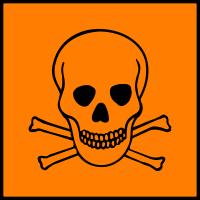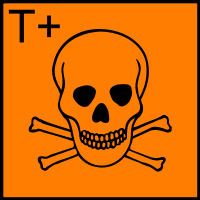NAMES AND DATABASE IDS
NAMES AND DATABASE IDS
Names Database IDs
|
IUPAC name
|
|
|
IUPAC Traditional name
|
|
|
Synonyms
|
|
Olah′s reagent
|
|
PPHF
|
|
Poly(pyridine fluoride)
|
|
Pyridinium poly(hydrogen fluoride)
|
|
Pyridinium polybifluoride
|
|
HF-Pyridine
|
|
Pyridine hydrofluoride
|
|
Hydrogen fluoride pyridine
|
|
Hydrogen fluoride/pyridine (55% HF)
|
|
Hydrogen fluoride-pyridine (70% HF)
|
|
Olah's Reagent
|
|
Hydrogen fluoride/pyridine (70% HF)
|
|
Hydrogen fluoride pyridine complex
|
|
pyridine hydrofluoride
|
|
HF-吡啶
|
|
氟化氢吡啶
|
|
吡啶氢氟酸盐
|
|
氟化氢吡啶络合物
|
|
|
|
|
CAS Number
|
|
|
MDL Number
|
|
|
Beilstein Number
|
|
|
Merck Index
|
|
|
PubChem SID
|
|
|
PubChem CID
|
|
DATA SOURCES
DATA SOURCES
All Sources Commercial Sources Non-commercial Sources
CALCULATED PROPERTIES
CALCULATED PROPERTIES
JChem
|
H Acceptors
|
1
|
H Donor
|
0
|
LogD (pH = 5.5)
|
0.6230428
|
LogD (pH = 7.4)
|
0.75354445
|
Log P
|
0.7555734
|
Molar Refractivity
|
23.9011 cm3
|
Polarizability
|
9.4423685 Å3
|
Polar Surface Area
|
12.89 Å2
|
Rotatable Bonds
|
0
|
Lipinski's Rule of Five
|
true
|
PROPERTIES
PROPERTIES
Physical Property
Safety Information
Product Information
Bioassay(PubChem)
|
Boiling Point
|
|
50°C/1mm
|
 Show
data source Show
data source
|
|
50°C/1mm
|
 Show
data source Show
data source
|
|
|
Flash Point
|
|
none°C
|
 Show
data source Show
data source
|
|
|
Density
|
|
1.1
|
 Show
data source Show
data source
|
|
1.1 g/mL at 20 °C(lit.)
|
 Show
data source Show
data source
|
|
1.100
|
 Show
data source Show
data source
|
|
|
Hydrophobicity(logP)
|
|
0.645
|
 Show
data source Show
data source
|
|
|
Storage Warning
|
|
Moisture Sensitive
|
 Show
data source Show
data source
|
|
MOISTURE SENSITIVE, KEEP COLD, TOXIC, CORROSIVE
|
 Show
data source Show
data source
|
|
Toxic
|
 Show
data source Show
data source
|
|
Very Toxic/Corrosive/Keep Cold
|
 Show
data source Show
data source
|
|
|
European Hazard Symbols
|
 Toxic (T) Toxic (T)
|
 Show
data source Show
data source
|
 Highly toxic (T+) Highly toxic (T+)
|
 Show
data source Show
data source
|
|
|
UN Number
|
|
1790
|
 Show
data source Show
data source
|
|
UN1790
|
 Show
data source Show
data source
|
|
|
MSDS Link
|
|
|
German water hazard class
|
|
3
|
 Show
data source Show
data source
|
|
|
Hazard Class
|
|
8
|
 Show
data source Show
data source
|
|
|
Packing Group
|
|
1
|
 Show
data source Show
data source
|
|
I
|
 Show
data source Show
data source
|
|
|
Risk Statements
|
|
26/27/28-35
|
 Show
data source Show
data source
|
|
|
Safety Statements
|
|
26-28-36/37/39-45
|
 Show
data source Show
data source
|
|
|
TSCA Listed
|
|
true
|
 Show
data source Show
data source
|
|
否
|
 Show
data source Show
data source
|
|
|
GHS Pictograms
|

|
 Show
data source Show
data source
|

|
 Show
data source Show
data source
|
|
|
GHS Signal Word
|
|
Danger
|
 Show
data source Show
data source
|
|
|
GHS Hazard statements
|
|
H300-H310-H314-H330
|
 Show
data source Show
data source
|
|
H300-H310-H330-H314-H318
|
 Show
data source Show
data source
|
|
|
GHS Precautionary statements
|
|
P260-P264-P280-P284-P301 + P310-P302 + P350
|
 Show
data source Show
data source
|
|
P260-P301+P310-P303+P361+P353-P304+P340-P305+P351+P338-P320-P330-P361-P405-P501A
|
 Show
data source Show
data source
|
|
|
Personal Protective Equipment
|
|
Faceshields, full-face respirator (US), Gloves, Goggles, multi-purpose combination respirator cartridge (US), type ABEK (EN14387) respirator filter
|
 Show
data source Show
data source
|
|
|
RID/ADR
|
|
UN 1790 8/PG 1
|
 Show
data source Show
data source
|
|
|
Storage Temperature
|
|
-20°C
|
 Show
data source Show
data source
|
|
|
Purity
|
|
95%
|
 Show
data source Show
data source
|
|
ca 70% HF
|
 Show
data source Show
data source
|
|
|
Compostion
|
|
hydrogen fluoride, ~70%
|
 Show
data source Show
data source
|
|
pyridine, ~30%
|
 Show
data source Show
data source
|
|
|
Linear Formula
|
|
C5H5N · (HF)x
|
 Show
data source Show
data source
|
|
DETAILS
DETAILS
 Apollo Scientific
Apollo Scientific
 Sigma Aldrich
Sigma Aldrich
Apollo Scientific Ltd -
PC4828

|
|
Convenient form of anhy. HF for hydrofluorination & halo-fluorination of alkenes and alkynes, ask for references.. Packaged in Nalgene bottles |
Sigma Aldrich -
184225

|
General description
May contain or form low levels of calcium fluoride during storage. Presence of this does not impact the specification values.
Packaging
25, 100 g in poly bottle
Application
Convenient form of anhydrous HF, stable up to 50°C. Has been used for the preparation of β-fluoroamines from amino alcohols and for the fluorination of acetylenes.1,2Used together with hypervalent iodine(III) reagents for ipso-fluorination of para-substituted phenols providing cyclohexadienones.3 Employed with Selectfluor™ (Catalog No. 439479) for geminal fluorination of 2,2-diaryl-1,3-dithiolanes.4
Reactant for preparation of:
• Epimers of shikimic acid with the features of fucosylated glycans via zinc-mediated reductive ring opening followed by a Barbier reaction
• Vaccinia H1-related (VHR) phosphatase inhibitor with a nonacidic phosphate-mimicking core structure
• Candidates for nucleic acid drugs
• ω-substituted gem-difluoroalkanes by oxidative desulfurization-difluorinationReagent for:
• Halofluorination reactions
Legal Information
Selectfluor is a registered trademark of Air Products & Chemicals, Inc.
Sure/Pac is a trademark of Sigma-Aldrich Co. LLC |
REFERENCES
REFERENCES
From Suppliers
 Google Scholar
Google Scholar

 PubMed
PubMed

 Google Books
Google Books

- • Convenient form of anhydrous HF, showing increased reactivity in many reactions: J. Org. Chem., 44, 3872 (1979). Alkenes and alkynes undergo hydrofluorination; in the presence of NIS or NBS, iodo- or bromofluorination occurs: Synthesis, 779 (1973). Secondary and tertiary alcohols are converted to alkyl fluorides: Synthesis, 653 (1974). Diazotization of ɑ-amino acids in the presence of the reagent provides good yields of ɑ-fluoro acids: Synthesis, 654 (1974). Reaction with aryldiazonium salts or triazenes leads to aryl fluorides, providing a convenient alternative to the Balz-Schiemann reaction (see Tetrafluoroboric acid, L14037): J. Am. Chem. Soc., 97, 208 (1975); J. Chem. Soc., Chem. Commun., 914 (1979); Bull. Chem. Soc. Jpn., 63, 2058 (1990).
- • In combination with nitrosonium tetrafluorborate, ketoximes are converted to gem-difluorides: Synlett, 425 (1994).
- • For use in electrophilic electrochemical fluorination, see: J. Fluorine Chem., 83, 31 (1997).
- • The reagent is also widely applied to the cleavage of a variety of silyl protecting groups including TBDMS, TES, TBDPS and TIPS: Synthesis, 453 (1986); J. Am .Chem. Soc., 112, 7001 (1990); for further discussion see: P. Kocienski, Protecting Groups, Thieme, Stuttgart (1994).
- Searching...Please wait...
PATENTS
PATENTS
 PubChem Patent
PubChem Patent
 Google Patent
Google Patent
